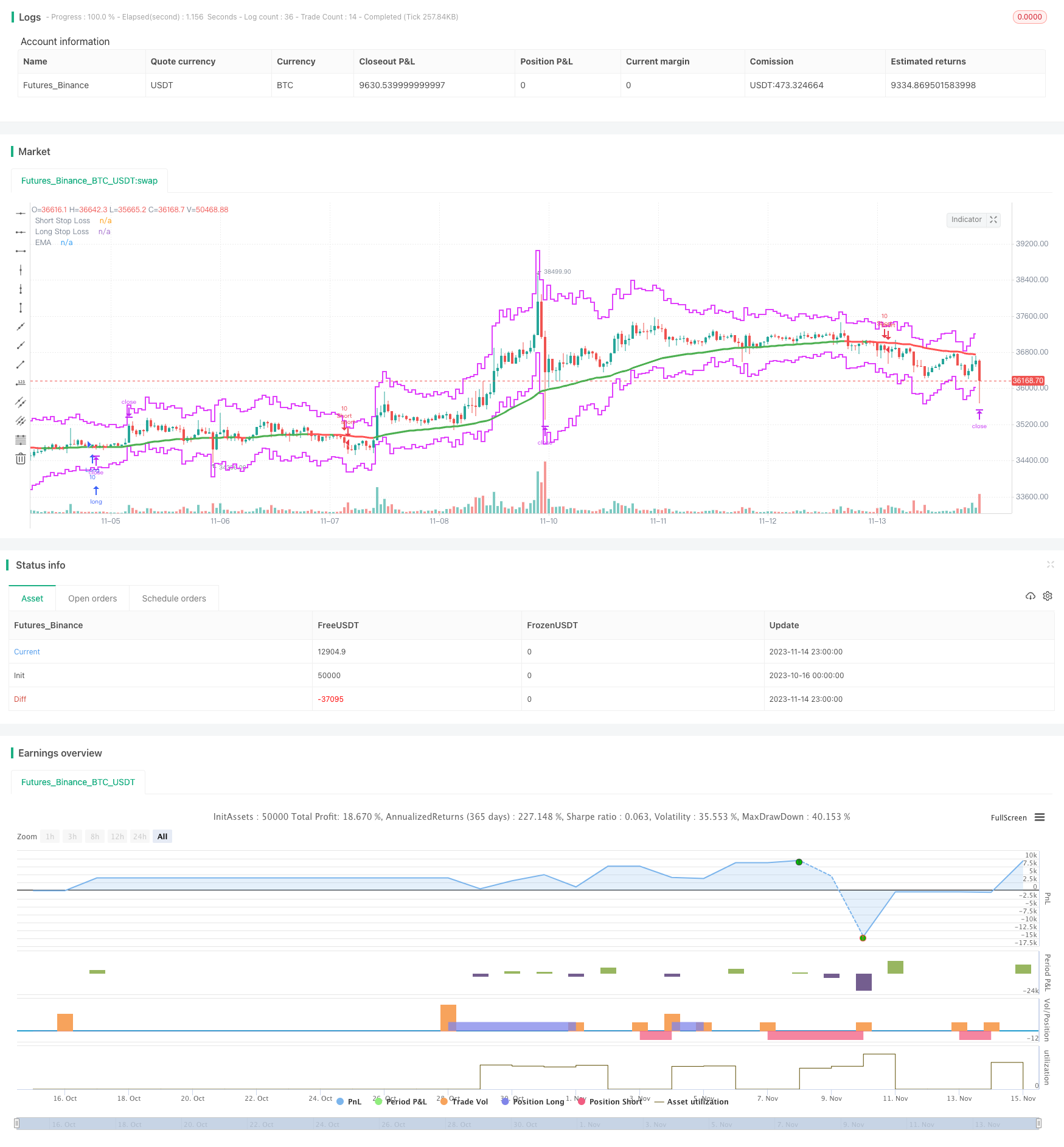
概述
该策略运用双重EMA均线的金叉、死叉形成信号,配合ATR指标判断市场波动率,实现低买高卖的趋势跟随策略。当快线金叉慢线,且ATR指标低于前一日时视为多头信号做多;当快线死叉慢线,且ATR指标高于前一日时视为空头信号做空。
策略原理
使用长度为20和55的双重EMA均线。当快线上穿慢线产生金叉时,视为多头信号;当快线下穿慢线产生死叉时,视为空头信号。
使用长度为14的ATR指标。ATR指标能反映市场的波动率和风险程度。当ATR低于前一日时,表示市场波动减弱,适合介入做多;当ATR高于前一日时,表示市场波动加大,适合介入做空。
只在快线金叉慢线且ATR低于前一日时做多;只在快线死叉慢线且ATR高于前一日时做空。避免在市场波动较大时轻易介入。
ATR指标还被用来设置止损位和止盈位。止损位为当前价减去ATR乘以止损倍数;止盈位为当前价加上ATR乘以止盈倍数。
止损倍数默认为3倍ATR,止盈倍数默认为3倍ATR。这使止损位和止盈位都能动态跟随市场波动。
策略优势
使用双重均线系统,能对多空状态判断提供较强确认。避免被市场常有的假突破误导。
ATR指标的引入,使策略只在低波动时介入,能过滤掉许多假信号,减少系统风险。
ATR动态止损止盈能使止损止盈随市场波动水平设定。避免止损太近或止盈过浅。
可设置是否采用均线交叉作为附加退出机制。可进一步优化系统的盈亏结果。
可根据ATR设定动态的止损和止盈水平,更符合趋势交易逻辑,止损不会过于敏感,止盈也不会过于宽松。
策略风险
双均线系统判断信号存在一定滞后。可能错过较强的短期趋势。
高波动时,ATR会上升,可能错过介入时机。应适当调整ATR参数。
长期持仓时,止损位可能会过于靠近,应结合趋势力度适当放宽。
均线系统对曲折盘整场景判断效果较差。应配合其它指标进行确认。
ATR参数应根据不同品种不同周期进行调整。参数选取不当会影响系统损益。
策略优化方向
可测试不同长度参数的均线组合,寻找更匹配该品种趋势特征的均线参数。
可以引入MACD,KD等其他指标,对均线交叉信号进行确认,提高 Entscheidungssicherheit。
可以通过回测优化ATR参数,使其更符合该品种的波动平稳特性。
可设置ATR倍数因子为可调变量,根据趋势强弱程度动态调整止盈止损位置。
可以结合趋势强度指标,在趋势不强时降低止损要求,在趋势强劲时增加止盈要求。
总结
该策略整合双EMA均线的趋势判断和ATR波动率指标的风险控制,形成了一个较完整的趋势跟随体系。策略优化的重点是调整均线和ATR参数使其更符合品种特性,以及设计动态止盈止损机制来跟随趋势强度变化。通过参数优化和逻辑优化,该策略可以成为一个优秀的趋势跟随策略。
/*backtest
start: 2023-10-16 00:00:00
end: 2023-11-15 00:00:00
period: 1h
basePeriod: 15m
exchanges: [{"eid":"Futures_Binance","currency":"BTC_USDT"}]
*/
//@version=4
// **********************************************
// PtahX EMA/ATR Strategy Public Release
// EMA Strategy with ATR & "Fear Factor" built in
// written by PtahX October 2019
// * modifications welcome
// * please let me know if you improve it so I can continue to learn :)
// * use at your own risk - I'm a new programmer and still learning
// * Best of luck on your trades!!
// Take Profit (TP) option based on ATR or MA Crossover
//***********************************************
strategy(title="PtahX EMA/ATR Strategy", overlay=true, pyramiding=1, calc_on_every_tick=true, default_qty_value=1, initial_capital=10000, slippage=2)
//*****************************
// Global Inputs
//*****************************
fastMA = input(title="Fast Moving Average", defval=20, step=1)
slowMA = input(title="Slow Moving Average", defval=55, step=1)
source = input(close, title="Source")
atrLength = input(title="ATR Length", defval=14, minval=7, step=1)
slMultiplier = input(title="Stop Loss Multiple", type=input.float, defval=3, minval=1, step=0.2)
tpMultiplier = input(title= "Take Profit Multiple", type=input.float, defval=3, minval=1, step=0.2)
maPlot = input(true, title="Plot EMA?")
maCrossoverExit = input(false, title="Exit with Slow MA Crossover?")
atrExit = input(true, title="Exit with ATR?")
//***********************************
// ATR
//***********************************
atr = atr(atrLength)
//***********************************
// Volatility Filter
//**********************************
// During uptrends the ATR indicator tends to post lower volatility.
// During downtrends, the ATR indicator tends to post higher volatility
volatilityBullish = atr < atr[1]
volatilityBearish = atr > atr[1]
//***********************************
// Moving Averages
//***********************************
// Double Line Plot Code (used for Entries & Exits not plotted by default)
fast = ema(source, fastMA)
slow = ema(source, slowMA)
maLong = crossover(fast, slow)
maShort = crossunder(fast, slow)
// Single Line Plot Code
bullish = slow > slow[1]
bearish = slow < slow[1]
barColor = bullish ? color.green : bearish ? color.red : color.blue
//*****************************
// Entries
//*****************************
entryLong = maLong and volatilityBullish
entryShort = maShort and volatilityBearish
if entryLong
sLoss = source - atr * slMultiplier
strategy.entry("Long", strategy.long, qty=10)
strategy.exit("Long Exit", "Long", stop=sLoss)
if entryShort
sLoss = source + atr * slMultiplier
tProfit = close > slowMA
strategy.entry("Short", strategy.short, qty=10)
strategy.exit("Short Exit", "Short", stop=sLoss)
//*****************************
// Exits
//*****************************
exitLong = 0
exitShort = 0
if maCrossoverExit
exitLong = maShort
exitShort = maLong
strategy.exit("Long Exit", "Long", when = exitLong)
strategy.exit("Short Exit", "Short", when = exitShort)
if atrExit
exitLong = source + atr * tpMultiplier
exitShort = source - atr * tpMultiplier
strategy.exit("Long Exit", "Long", limit = exitLong)
strategy.exit("Short Exit", "Short", limit = exitShort)
//******************************
// ATR Based Exit/ Stop Plotting
//******************************
// Stop Loss Calculations
longStopLoss = source - atr(atrLength) * slMultiplier
shortStopLoss = source + atr(atrLength) * slMultiplier
longTakeProfit = source - atr(atrLength) * slMultiplier
shortTakeProfit = source + atr(atrLength) * slMultiplier
//*********************************
//Chart Plotting
//*********************************
//ATR Based Stop Losses
plot(shortStopLoss, color=color.fuchsia, offset=0, transp=0, show_last=5, linewidth=2, style=plot.style_stepline, title="Short Stop Loss")
plot(longStopLoss, color=color.fuchsia, offset=0, transp=0, show_last=5, linewidth=2, style=plot.style_stepline, title="Long Stop Loss")
// Single Slow EMA Option
plot(slow and maPlot ? slow : na, title="EMA", color=barColor, linewidth=3)